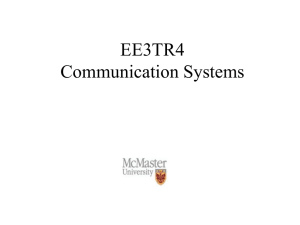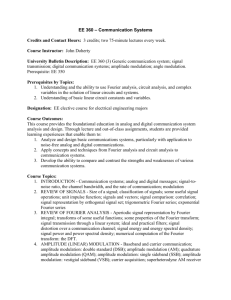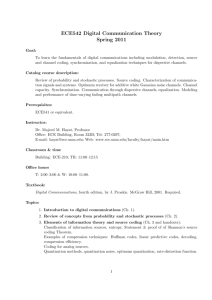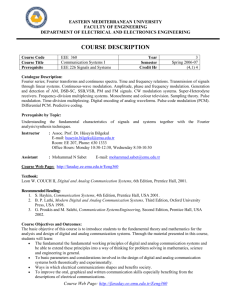S-72.244 Modulation and coding methods
advertisement
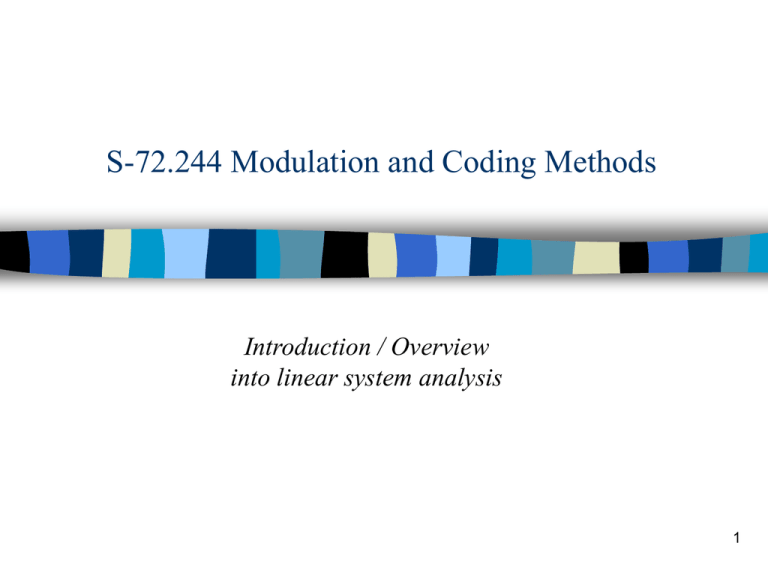
S-72.244 Modulation and Coding Methods Introduction / Overview into linear system analysis 1 S-72.244 Modulation and Coding Methods: Practical arrangements (2 cr) Lectures: Timo Korhonen, Otakaari 8, room 209, 2. Floor, phone 451-2351, timo.korhonen@hut.fi Tutorials: Jahangir Sarker, Otakaari 5, phone 451-2347, jahangir.sarker@hut.fi Lectures on Mondays, 14-16, hall S1. Tutorials on Thursdays, 12-14, hall S5 (Exercises carry bonus points!) Text books : – A.B. Carlson: Communication Systems, IV ed – B.P. Lathi: Digital and Analog Communication Systems – Reference: J. G. Proakis: Digital Communications Homepage http://www.comlab.hut.fi/opetus/244 2 Course outline, fall 2001 Introduction Linear modulation Exponential modulation Carrier wave systems Noise in carrier wave systems Revision I Sampling and pulse coded modulation I Sampling and pulse coded modulation II Baseband digital transmission Error control coding I Error control coding II Bandpass digital transmission Revision II 3 Introduction Electrical systems utilize varying currents, voltages (eg. varying electromagnetic fields) to store and convey information Telecommunication systems are dedicated to transporting information from point to point using links or networks Telecommunication messages are transmitted via different media as copper wire, microwave or optical fiber Signal is adapted to the transmission and media by modulation and coding 4 Motivation for applying modulation and coding Modulation is done to enable to use the media for the intended message. Thus the modulation scheme is selected based on • Message to be transmitted as – voice – data – continuous / bursty traffic • Allowed delay • Media that is to be used; compare – Note that for instance in wireless networks a different modulation method can be more appetizing than in wireline local area networks (LANs) or in public switched telephone network (PSTN) 5 Motivation for applying modulation and coding (cont.) Coding is done ... – For detection and/or correction of errors produced by the channel (as block and convolutional coding) by • noise • interference • distortion – linear – nonlinear – To alleviate synchronization problems (as Manchester coding) – To alleviate detection problems (as differential coding) – To enable secrecy (as scrambling or ciphering) Channel coding principles: – ARQ (Automatic Repeat Request) – FEC (Forward Error Correction) 6 A classification of communication systems Communication systems balance between different efficiencies With respect of markets, systems is a failure if anyone of these efficiencies criteria is not met for a particular application platform: 7 System efficiencies, examples Microwave links: – good bandwidth efficiency, low error rate required – power efficiency and cost not so important Wireless mobile systems: – power, bandwidth and cost efficiency very important – earlier bandwidth efficiency was easiest to compromise – nowadays signaling rates increase and bandwidth efficiency is becoming more and more important issue It is most important that a system designer should recognize communication system relationship to these basic qualifiers: 8 Telecommunication research areas 2001 9 Unmodulated sinusoidal The sinusoidal wave is parameterized by constant amplitude, frequency and phase: All parameters known, thus: convoys no information! Mathematically and experimentally convenient basic formulation whose parameterization by variables enables presenting all the modulation formats: x(t ) A(t ) cos ct (t ) 10 Practical signals A set of voice tones: – Several tones superimposed – Tones can not be separated from the time domain representation – Frequency components can be separated from a frequency domain representation “This is some speech” – – – – Bursts Amplitude varies Frequency (phase) varies Many other practical sources are bursty as • video signals • data packets (for instance in Ethernet) 11 Time domain representation can only seldom reveal small superimposed signals 12 Frequency domain representation of the same signal reveals more! 13 Examples of other signals’ spectra All finite signals have spectra that can be computed via Fourier transformations or Fourier series 14 Noise and interference In practical communication systems signals are blurred by noise and interference: Time Domain Frequency Domain 15 A short review to signals and systems (A) Signals and spectra – Line spectra, Fourier series • Phasors and line spectra • Periodic signals - average power • Parseval’s power theorem – Fourier transform and continuous spectra • Fourier transforms • Rayleigh’s energy theorem • Duality – Time and frequency transformations 16 Signal classification Deterministic signals Random signals; purely and pseudo-random Energy signals; pulses Power signal; periodic Also: Continuous time - discrete time: x(t ), x[n] x(nTS ), X ( f ), X [k ] Analog - digital Real - complex 17 Deterministic signals Deterministic signals are signals which are completely specified as a function of time. Examples of deterministic signals: A cos 2 f C t exp( at ) (t / T ) (t / T ) (t ) u '(t ) du (t ) / dt Some properties for delta function (t ) : (t ) (t ) x(t ) (t t ) x(t ) (t t ) 0 0 0 (t t0 ) (t )dt (t0 ) (at ) (t ) / a (n) n (n) (t t0 ) (t )dt ( 1) (t0 ) 18 Example Verify that (at ) (t ) / a Proof is based on equivalence property, e.g. two functions f1 and f2 are equal only if f ( t ) ( t ) dt 1 f 2 (t ) (t )dt where (t) is any function. Consider thus now an integral 1 ( at ) ( t ) dt ( ) ( / a) d a 1 1 (0), a 0; if a 0 equals (0) a a and thus 1 a (at ) (t )dt (0) (t ) a (t )dt 19 Random signals Random signals are signals that take a random value at any given instance of time These signals must be modeled probabilistically (e.g. using distribution functions as PDF and CDF) The discrete and continuous mean (e. g. mean for a discrete variable) is defined by K x(n) mx x[i] p[i] mx xpx ( x)dx i 1 A where A is the span where p(x) exists. The variance (AC power) is defined by K mx ( xk mx ) k 1 2 2 mx2 x 2 p( x)dx A T /2 The RMS value is x (t )dt / T mx mx 2 2 2 T / 2 20 Using MathCad for calculating averages and variances 21 22 Energy and power signals The normalized energy of a signal (pulse) is E x(t ) dt Examples of energy signals (t / ) (t / ) For periodic signals average power is defined instead of energy 1 P T P T 1 lim x ( t ) dt T / 2 x(t ) dt A cn T T / 2 Note that some signals are not energy or power signals as: y(t ) u(t ), y(t ) t 2 , t 0 2 T /2 2 T /2 2 2 Wiener-Kinchine theorem defines an important relationship between PSD P() and autocorrelation Rxx P( ) X ( ) F Rxx Rxx ( )exp( j )d 2 23 Correlation and convolution Correlation between signals x and y is defined by Rxy T x(t ) y (t )dt Convolution is defined by T x y(t ) T x(t ) y( t )dt T The Fourier transform of an autocorrelation yields the PSD 2 F x(t ) x(t ) X ( f ) X *( f ) X ( f ) Signal energy (or power) can be calculated in time domain or in frequency domain 2 2 E X ( f ) df x(t ) dt Rxx (0) Correlation is often used to find out PSD for random signals Convolution is used for determining output of linear systems 24 Fourier transform and Fourier series F-transforms are used to analyze pulses, F-series for analyzing periodical signals Definitions, Fourier transform: F [ y (t )] Y ( f ) y (t )exp(2 ft )dt F [Y ( f )] y(t ) Y ( f )exp(2 ft )df 1 Fourier series: y (t ) cn exp( jn 0t ) n cn T0 1 T0 / 2 y (t ) exp( jn 0 t )dt T0 / 2 Total signal power (Parseval’s theory): Ptot To 1 T0 / 2 cn x(t ) dt n T0 / 2 2 2 25 Some Fourier transforms 26 Some Fourier transforms (cont.) 27 Inspecting Fourier series using Mathcad T0 / 2 compare: cn T0 y (t )exp( jn0t )dt T / 2 1 0 28 Inspecting Fourier series by Mathcad (cont.) 29 Inspecting Fourier series by Mathcad (cont.) compare : y(t ) cn exp( jn0t ) n 30
